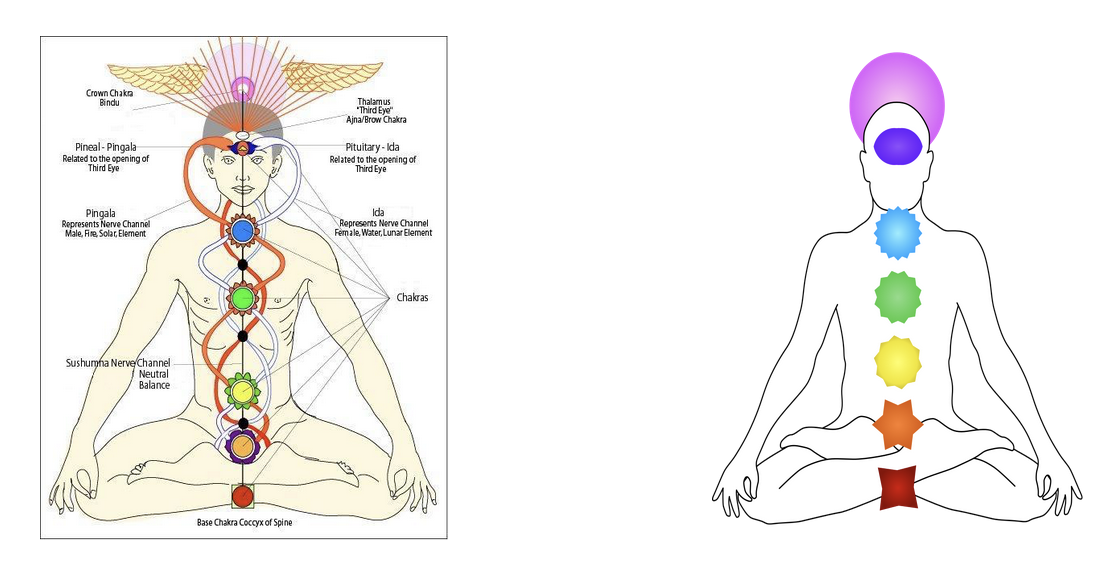by Lisa Funk
Prana, or life force energy, is drawn into the body through the breath and moves through the body along channels called nadis. There are many nadis, but three of particular importance. The central channel is the sushumna nadi. The two main nadis, ida and pingala move in a crisscross, spiraling fashion along this path. Where these energy channels cross there are energy centers, or wheels, called chakras.
In yoga, we create balance in the chakra system by moving the prana. The seven main chakras are arranged vertically along the sushumna nadi from the base of the spine to the crown on the head. These energy centers regulate the flow of prana. Together the seven chakras form a formula for wholeness that integrate the mind, body and spirit. Pain, disease, discomfort, or general disharmony can occur when there are even minor disturbances in the subtle body. Investigating the chakras is a way to gauge your entire system.
1-Muladhara: root chakra (red)
The area of the body: base of the spine.
This chakra is associated with your sense of security and familial relationships. When this chakra is unbalanced, you may feel depressed, anxious, or even constipated. When the root chakra is balanced, you will find contentment, happiness, and inner peace. You will have more compassion and patience towards yourself and those around you. A balanced root chakra brings emotional stability and an incredible sense of being able to cope with whatever the universe throws your way.
2-Svadhisthana: sacral chakra (orange)
The areas of the body: sacrum, hips, sexual organs.
This chakra is connected to sensuality and creativity. The function of the sacral chakra is pleasure and overall enjoyment of life. Blocked energy in the sacral chakra can result in low back pain, reproductive issues, urinary tract infections, and bladder and kidney issues. When in alignment, you will have the energy for creativity, movement, pleasure and relationships.
3- Manipura: solar plexus chakra (yellow)
The areas of the body: abdomen, mid-back, side body, core.
This energy center is associated with self-esteem, sense of purpose, digestion, and personal identity. When blocked, you may lack energy, feel weak, have allergies, or have liver and digestive problems. If balanced, you will feel energy, strength, and confidence. Manipura chakra is all about being able to deal with things. Can you stand up for yourself? Are you strong and courageous? Allowing yourself to grow and become a better version of yourself means taking action and leaving behind what no longer serves you.
4- Anahata: Heart chakra (green)
The areas of the body: heart, chest, shoulders, arms, hands, upper back.
This chakra serves as our center for love for oneself and others, compassion, and forgiveness. The heart chakra affects the heart, lungs, chest, arms and hands. When misaligned, you may feel lonely, jealous, defensive, and have difficulty trusting others. When the heart chakra is open, you will feel love, compassion, and joy. Find love, kindness and compassion as you open your heart to new experiences and new people.
5- Vishuddha: Throat chakra (blue)
The areas of the body: throat, neck, mouth, jaw, ears, and even the shoulders.
The throat chakra connects the lower chakras to the higher ones. It connects the energies between your basic needs and your higher wisdom.
If the throat chakra is blocked, you may feel depression, anxiety, or low self-esteem. When difficult situations arise, you may shut down, instead of speaking up. A blocked throat chakra may manifest in thyroid problems, sore throat, gum disease, ear or sinus infections, or tight shoulders. Once opened and balanced, you will be able to articulate your ideas, feelings and opinions openly. You may also find that you feel heard and understood. Speak your truth and listen with compassion. Are my words true? Are my words necessary? Are my words kind?
6- Ajna: Third eye chakra (indigo)
The areas of the body: Center of the forehead in the space between the eyebrows and inside the mind.
Higher knowledge, intuition, imagination and visualization are all connected to the third eye chakra. If blocked, you may feel eye strain, headaches, migraines, anxiety, memory issues, or insomnia. An open and balanced third eye results in clear thoughts, stronger intuition, and the ability to see things as they actually are. See deep within yourself, into your intuition and inner knowing, trust your intuition.
7- Sahasrara: Crown chakra (violet)
The areas of the body: crown of head and skull.
This chakra is associated with thought, connection to spirit, wisdom, and self-knowledge. Signs of a blocked crown chakra may include confusion, imbalance, poor coordination, or lack of focus. When in balance, you will feel more at ease, relaxed, clear-headed, and connected. Some questions to ask yourself: What is my purpose? How can I best serve the whole? An open crown chakra understands that everything is connected and it allows us to put our shortsighted self-interests aside in service of the whole. The crown chakra opens up to a boundless sense of oneness and connection.


